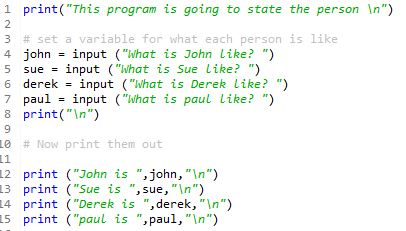3. High-level languages
High level languages were developed in order to make programming a lot easier for people, compared to coding in machine code.
A high level language has two main features
- It has a set of keywords such as PRINT or IF
- It has a set of grammar rules (syntax) which define how to combine them correctly
A programmer writes source code (programming code) using the allowed set of keywords and its syntax rules.
There are many high level languages. For example Java, Python, C++, C and so on. High-level languages are "machine-independent". That means that they can be ported to different computers and still run.
Some Python source code is shown below

It shows typical keywords such as 'print' and 'input'. They are easier to read and understand compared to a low level language.
However, source code needs to be converted into machine code to run in a CPU.
This is the task of a piece of software called a 'translator' which we discuss next.
Challenge see if you can find out one extra fact on this topic that we haven't already told you
Click on this link: What is a high level language
